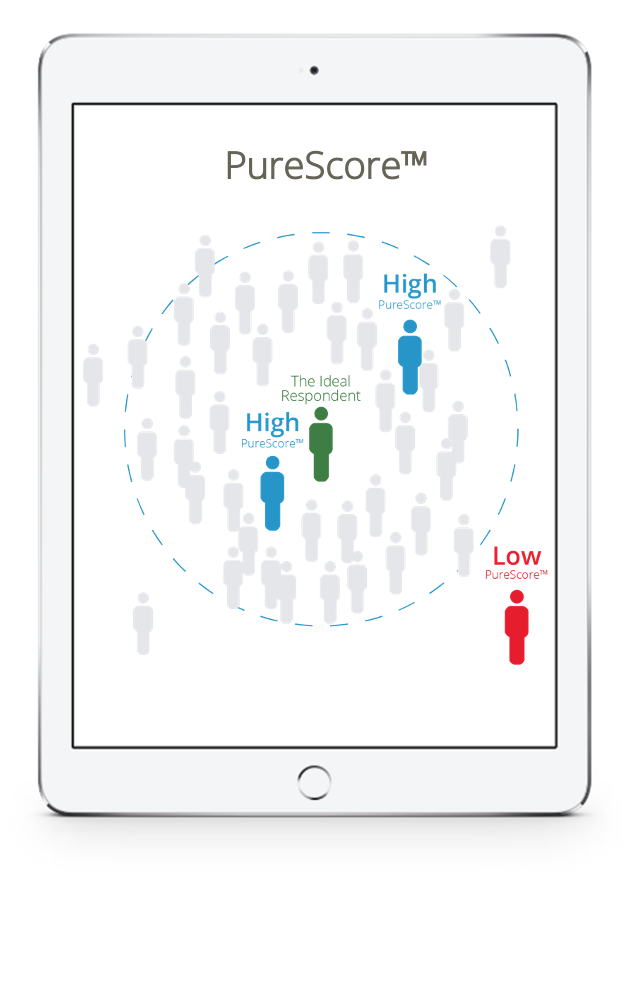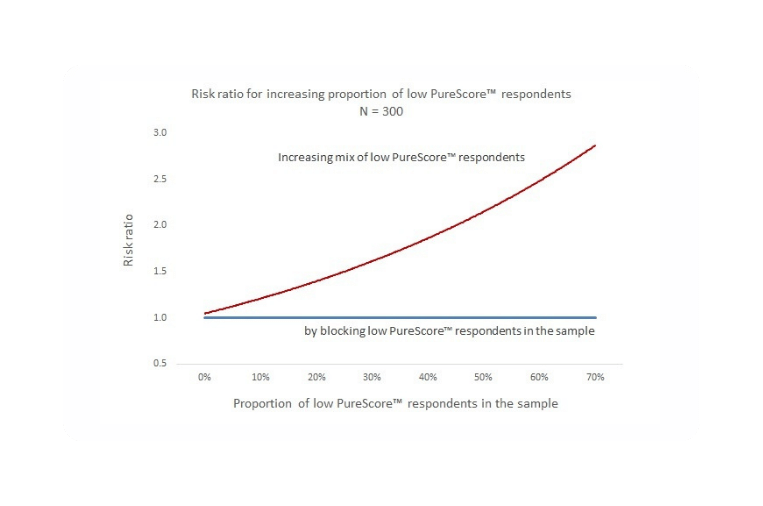Data Quality Case Study: PureScore™
How Do You Ensure Data Quality in a Survey?
PureSpectrum is known for its innovative techniques to address data quality issues that focus on the inherent quality of respondents instead of just their responses in surveys. Our respondent level scoring system, PureScore™, is an advanced machine learning algorithm that ingests thousands of data points from various aspects of respondent behavior and scores every respondent on the platform. Any respondent with low PureScore™ is prevented from taking surveys.
More than 10% of transactions on the PureSpectrum Marketplace Platform are removed because of PureScore™ to minimize unnecessary risk. But as PureSpectrum grows and rapidly onboards new countries, suppliers, and buyers, it is important to isolate and truly quantify the impact of PureScore™. Thus, we created an evidence-based case study which we refer to as Research-on-Research to prove the effectiveness of PureScore™ inherent to the respondent pool itself.
Data Quality Research: How PureScore™ Reduces Risk

Respondents with a low PureScore™ dramatically increase the risk of questionable data. How?
We screen participants and make sure you only get the best and highest quality respondents into your project.
PureScore™ gives you the highest confidence in the insights you are drawing from your audience. How?
PureScore™ effectively quantifies every step of the respondent journey and gives visibility into behavior beyond a single session.
PureScore™ ensures that you are making the best business decisions possible. How?
This Research-on-Research showcases that data collection without PureScore™ has a higher risk associated. The data from respondents with low PureScores™ increases the odds of bad decisions being made for your business.
Research-on-Research Process to Identify the Effectiveness of PureScore™
To achieve our Research-on-Research, we used a measure of association that compares deviation from expected behavior in one group with deviation from expected behavior in the other group. We then use the risk ratio to help us identify the effectiveness of PureScore™ in terms of risk, studying how PureScore™ helps mitigate risk and increases the quality of the survey respondent pool by removing high-risk respondents. This Research-on-Research Case Study was designed to compare respondents with low and high PureScores™ and evaluate the risk involved in absence of the PureScore™ quality check.

Research-on-Research Key Results
Low PureScore™ Respondents Pose Double the Risk
According to this study, the respondents with low PureScores™ pose double the risk relative to their high-quality score counterparts, and as the sample size increases, the risks involved in unreliable responses and data also increase exponentially.
PureSpectrum Reduces Risk in Millions of Surveys
Since the inception of PureScore™, PureSpectrum has reduced risk in millions of surveys by preventing low-quality, fraudulent respondents from reaching the buyer surveys, thus securing and improving the integrity and reliability of the data collected. Our various third-party tools and in-house innovative AI/machine learning techniques have developed visibility into survey respondent behavior beyond a single session behavior. Our technology effectively profiles the past behavior of the survey respondents to evaluate their credibility, reliability, and consistency. By removing the risk involved in multiple sample sources with PureScore™, PureSpectrum constantly delivers world-class data quality to our customers improving research and thus making life, easier.
Read the Case Study
Fill out the form below to download our full research report
Methodology
A 10-minute survey on social media’s influence on purchasing was designed to answer the relative risk questions. The questionnaire included 21 questions with 16 sub-sections collecting 37 data points. Binary/categorical responses were chosen to establish consistency, and scale rating responses and ordinal responses to calculate the risk ratio. Open-end responses were evaluated for data quality.
The survey was administered on the PureSpectrum Insights Platform which provides an end-to-end survey programming, administering, and reporting, seamlessly integrating with the PureSpectrum Marketplace Platform to ensure the required sample supply.
300 randomly selected respondents with high PureScores™, and 300 randomly selected respondents with low PureScores™, both sourced from the PureSpectrum Marketplace, completed the survey over eight days in field. Demographic data on gender, age, income, race, and device used was also collected to ensure normalization.
The Research Team

Mark Menig
Chief Product Officer
Mark has nearly 20 years of experience in global business leadership, corporate entrepreneurship, and technology innovation. He has worked passionately within the industry building businesses, tools, and gathering evidence to improve data quality.
In his current role as Chief Product Officer of PureSpectrum, he oversees product, engineering, data science, and supply teams across 6 countries and works to deliver new PureSpectrum features that will continue to improve and move the industry forward. Mark graduated from the University of Washington with a double major in Marketing and Corporate Entrepreneurship and added a Certificate in Contract Management from the University of Washington Extension School.

Sushma Vasudevan
Vice President, Analytics and Data Science
Sushma is responsible for developing state-of-the-art tools for PureSpectrum that provide customers with real-time decision-making and fraud detection.
With more than 16 years of experience in Quantitative Analysis, Sushma leads the industry with her deep knowledge of Advanced Machine Learning/Artificial Intelligence techniques and intricate understanding of Market Research methodologies. Her contributions help transform PureSpectrum products with a data-driven sophistication. She also sits on the Advisory Board at the Center for Economic Forecasting and Research and teaches Market Research and Statistics as an Adjunct Professor at California Lutheran University.
